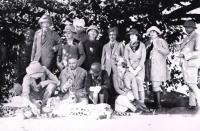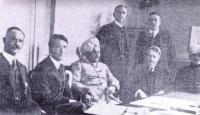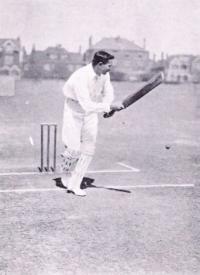Sport: Ranji—the cricketing maharajah of Connemara
Published in
20th Century Social Perspectives,
20th-century / Contemporary History,
Features,
Issue 4 (July/August 2010),
Volume 18

Ranji (with cigarette in mouth) with European guests on a tiger hunt in Nawanager. His lavish hospitality was legendary and much abused—one of the reasons he ‘escaped’ to Connemara. (Private collection)
On 17 July 1924, as the mail boat docked at its usual berth in Kingstown, it brought the first head of state to the new Irish Free State. A contingent of the newly formed Irish National Guard and a number of Irish Free State ministers waited on the quayside. After a slight delay, to the astonishment of a group of curious bystanders, a figure in a silk dress coat, white leggings and a turban adorned with a large emerald emerged from the mail boat. His dark face wreathed in smiles, he advanced to greet the waiting ministers. Thus began the nine-year association with Ireland of His Highness Kumar Shri Ranjitsinhji, Jam Saheb of Nawanager, a small state in north-western India.
First non-white to play cricket for England
Few in Ireland at the time knew much about this exotic guest of the nation or why he had come to Ireland. As photos of his courtesy visit to President W.T. Cosgrave at government buildings, and later as guest of honour at the Tailteann Games in Croke Park, appeared in the national newspapers, it emerged that Prince Ranjitsinhji was none other than the famous cricketer ‘Ranji’, whose cricketing wizardry had triumphed over racism and personal adversity to make him the first non-white to play test cricket for England. Inventor of the ‘leg-glance’ stroke, creator of batting records that still stand, he had mesmerised a generation of cricket fans with the brilliance of his play. And behind the public persona lay a personal life that seemed, on the surface, in the tradition of a Bollywood movie. Like many of his fellow maharajas, Ranji was extravagant and addicted to all things western. A part-time absentee, he spent much of each year in England and Europe, where his lavish hospitality was legendary and much abused.
Passion for fly-fishing

On a courtesy visit to President W.T. Cosgrave and other government ministers at government buildings. (Weekly Irish Times, 26 July 1924)
The desire to escape from his mounting debts, irate debtors and sponging friends, as well as to indulge his passion for fly-fishing, which by 1924 had replaced cricket as his chosen sport, made him look outside England. That Ranji should have chosen the Irish Free State, just recently violently broken away from the empire that he supported, is more a matter of fate. As a member of the Standing Committee of Indian Princes representing the interests of the independent Indian states in the face of the growing nationalism of Ghandi and Nehru, Ranji was appointed a legate to the Assembly of the League of Nations in 1923. At Geneva he made the acquaintance of the Irish delegation, led by W.T. Cosgrave, president of the new Irish Free State, who encouraged him to come to Ireland.
When Ballynahinch Castle and its famous salmon and sea-trout fisheries became available to rent in 1924, Ranji decided to test the water. From Dublin he travelled by train to Galway, and from there, on the Clifden line, to Ballynahinch station. His unusual entourage included his constant ‘companion’, Welsh-born Margaret Williams, fellow test and Sussex team member C.B. Fry, who acted as his secretary, his nephews and nieces, his state officials, and numerous Indian and Arab servants. Ranji fell in love with Ballynahinch and decided to purchase the estate with its 30,000 acres of land, lake and river from the Berridge family. Despite opposition from some local clergy, the people of Connemara welcomed the new owner of Ballynahinch. Ever the diplomat, Ranji was careful to respect local and religious traditions. ‘Ranji had his ways and we had ours,’ one local later observed.
Became the biggest emloyer in Connemara

Ranji’s cricketing wizardry triumphed over racism when, in 1896 against Australia, he become the first non-white to play test cricket for England in a career that set batting records that still stand today. (Reinhold Thiele)
For the next nine years ‘the Ranji’, as he became more familiarly known, put his celebrity status and talents to work to improve the lives of the people in the locality, whose living conditions were as bad as those in any part of India. Living in thatched cottages, most with earthen floors, without electricity, running water or sanitation, tuberculosis and typhus were widespread. Meagre income came from subsistence farming supplemented by some inshore fishing. Ranji lent his support to the establishment of cottage industries, the breeding of Connemara ponies and fish conservation, and contributed to church-run events. He initiated innovation and improvement schemes on his estate, giving jobs to over 50 local people, making him the largest employer in Connemara. He became the fledgling Irish Tourist Board’s dream, as his presence in Ireland and his entertainment of many high-profile guests at Ballynahinch helped elevate Ireland as a tourist destination. ‘If it’s safe enough for Ranji it’s safe enough for anyone,’ one report stated. Sending his nieces to be educated by the Benedictine nuns at nearby Kylemore Abbey further confirmed his commitment to Connemara.
And the locals took their Indian landlord to their hearts. ‘The Ranji’s’ annual arrival in Ballynahinch was heralded by fog detonators placed on the railway line. Alighting at the little station, he was warmly welcomed by his Irish employees. His official birthday on 8 September was celebrated with a party for all his employees and friends at the castle. In an age when crossing the racial line was still taboo, his Indian staff integrated well with the local community, with a least one amorous liaison resulting. As their Indian dress was unsuited to the Irish climate, Ranji had a tailor in Clifden make up Irish serge suits for his staff. His fleet of small cars were often placed at the disposal of locals, most notably at election time and for providing transport to Clifden. Away from the glare of publicity, Ranji’s life in Connemara was remarkable for its simplicity. Fishing, driving, whist and low-key entertaining of family, close friends and locals replaced the high profile and extravagance of his lifestyle in India and England.
From 1924 until 1932 Ranji divided his time between Nawanager and Ballynahinch. Connemara—‘the most beautiful place of all’—was where he escaped for a little while from his mounting financial problems and his growing political disillusionment with empire. In April 1933, as his Irish staff prepared the castle for his annual return, they heard with disbelief of ‘the Ranji’s’ unexpected death on the radio. His beloved Ballynahinch was sold the following July. HI
Anne Chambers is a biographer, novelist and short story writer.
Further reading:
A. Chambers, Ranji: Maharajah of Connemara (Dublin, 2002).





















